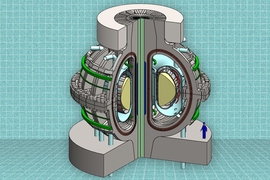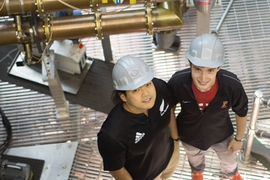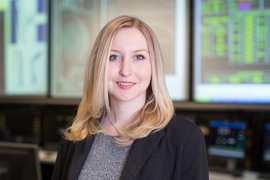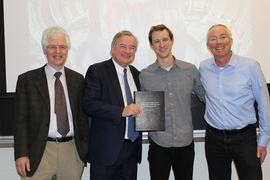Alex Tinguely wonders where he might be today if he had not taken an online physics class in high school. The second-year Department of Physics graduate student from Fort Madison, Iowa, attended a high school with a population of no more than 100 students, and with no available physics courses.
In his junior year he decided if he was going to explore the world of physics he would need to do it online, and on his own. With no lab space available, Tinguely adapted the school chapel to his needs.
“One experiment I did was stack our hymnals to form a ramp that I could roll a ball down. I was trying to calculate the acceleration due to gravity by varying the slope of the ramp. At least one teacher knew that I was in the chapel, but I'm not sure about the others. They probably would not have been too happy.”
In the process of his chapel experiments, Tinguely found physics so compelling he decided to take an online Advanced Placement Physics course during his senior year.
Attracted by the breadth of research possible in the field, Alex majored in physics and mathematics at Iowa State University. Between his junior and senior years he had the opportunity, through the U.S. Department of Energy (DOE) Science Undergraduate Laboratory Internship program, to study at a DOE lab. Feeling that the topic of nuclear fusion sounded promising, he ended up at the Princeton Plasma Physics Laboratory (PPPL). He spent the summer studying dusty plasmas with Arturo Dominguez, whose graduate work at MIT’s Plasma Science and Fusion Center (PSFC) had led to his position as PPPL’s science education and program leader.
Today, Tinguely finds himself in a PSFC control room, acquiring data from the same Alcator C-Mod tokamak Dominguez used for his thesis research. Working with his advisor, principal research scientist Bob Granetz, he studies how to magnetically confine plasmas in a toroidal vacuum vessel, so that fusion can occur. His focus now is on disruptions, often caused by instabilities in the plasma, which can damage the walls of the fusion vessel.
“We need to figure out how to prevent disruptions if we want our tokamak to work and survive.”
Tinguely is particularly interested in runaway electrons, which can be caused by disruptions. These electrons, which have accelerated to nearly the speed of light, can carry a lot of energy: 1,000 times more than the normal thermal energy of electrons in the plasma. If runaway electron beams are created in a fusion device, they can eventually strike a wall and cause serious — potentially catastrophic — damage to the vessel.
The disruption scenarios Tinguely studies are comparable to what could occur in the ITER Project, a large-scale fusion experiment being built in France to demonstrate the technological and scientific feasibility of magnetic confinement fusion. “If we can predict disruptions on C-Mod, hopefully we can predict them on ITER,” Alex says.
His research takes Tinguely inside the compact vacuum vessel of the Alcator C-Mod tokamak, an opportunity he describes as “one of the coolest experiences ever.” Inside a machine that can reach temperatures of 100 million degrees, he calibrates spectrometers so that they can accurately measure the amount of light coming from the synchrotron radiation of runaway electrons. For Tinguely, working inside the tokamak provides a unique learning experience, one that places a lot of responsibility on the students, but teaches great skills.
Tinguely is eager to share his enjoyment of physics and fusion research with others. At the PSFC he is honing the talent for educational outreach that he nurtured as a member of the Iowa State University Physics and Astronomy Club, where he helped put on science demonstrations at local elementary schools and on campus. Giving a tour of the PSFC, he might be found explaining how to play a video game that challenges participants to keep a plasma from touching the walls of the vessel, or inviting a high school student to hold a large magnet up to a glow-discharge tube filled with plasma, to illustrate how plasmas respond to magnetic fields.
“I think it’s really fun to do and hopefully gets kids interested in science,” Tinguely says. “It was very much by chance that I became interested in physics.”
Looking back on his decision to take an online physics course, and how it led him on a path to MIT, Tinguely seems committed to sparking that same interest in the minds of the students he meets.
“My end goal is to hopefully help build a fusion reactor some day,” he says. And it looks like he’s hoping to inspire others to join him.










